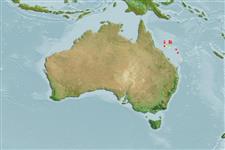Common names from other countries
Élasmobranches (requins et raies) (sharks and rays) >
Rajiformes (Skates and rays) >
Anacanthobatidae (Smooth skates)
Etymology: filicauda: Name from Latin ‘filum’ meaning thread and ‘cauda’ for tail or appendage, referring to its thread-like tail tip..
More on authors: Last & Séret.
Environment: milieu / climate zone / depth range / distribution range
Écologie
marin bathydémersal; profondeur 606 - 880 m (Ref. 75174). Tropical; 17°S - 25°S, 149°E - 156°E (Ref. 75174)
Western Pacific: (Queensland) Australia, possibly more widespread in Northern Coral Sea (Refs. 75174, 114953).
Taille / Poids / Âge
Maturity: Lm ? range ? - ? cm
Max length : 55.0 cm TL mâle / non sexé; (Ref. 75174)
Description synthétique
Clés d'identification | Morphologie | Morphométrie
This species is distinguished by the following set of characters:: disc large, width at anterior orbit 5.7-8.1 times mouth width; tail short, postcloacal length 97-140% of disc length; eyes relatively large, orbit diameter 7.1-9.6 in horizontal snout and 9.4-11.3 in head lengths respectively; distal portion of tail not expanded, width of tail near tip 0.7-1.1 times tail width at its midlength; pectoral-fin radials 71-75; pelvic fins moderate-sized, anterior lobe 14.8-16.2% TL; anterior pelvic-fin lobe rather broad-based, width 1.6-2.5 in distance between pelvic-fin origins; caudal fin rudimentary; tooth rows in each jaw of adults 18-22; teeth of adult males with very short cusps; monospondylous vertebral centra 27-30, total centra 155-182; dorsal surface uniformly pale pinkish brown, ventral surface pale, translucent (Ref. 75174).
Life cycle and mating behavior
Maturities | Reproduction | Spawnings | Egg(s) | Fecundities | Larves
Last, P.R. and B. Séret, 2008. Three new legskates of the genus Sinobatis (Rajoidei: Anacanthobatidae) from the Indo-West Pacific. Zootaxa 1671:33-58. (Ref. 75174)
Statut dans la liste rouge de l'IUCN (Ref. 130435)
CITES (Ref. 128078)
Not Evaluated
Menace pour l'homme
Harmless
Utilisations par l'homme
Outils
Articles particuliers
Télécharger en XML
Sources Internet
Estimates based on models
Preferred temperature (Ref.
115969): 5.5 - 8.2, mean 6.3 (based on 7 cells).
Phylogenetic diversity index (Ref.
82804): PD
50 = 0.5020 [Uniqueness, from 0.5 = low to 2.0 = high].
Bayesian length-weight: a=0.01000 (0.00244 - 0.04107), b=3.04 (2.81 - 3.27), in cm Total Length, based on all LWR estimates for this body shape (Ref.
93245).
Niveau trophique (Ref.
69278): 3.8 ±0.6 se; based on size and trophs of closest relatives
Fishing Vulnerability (Ref.
59153): Moderate vulnerability (42 of 100).
